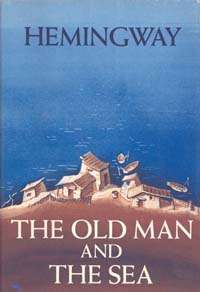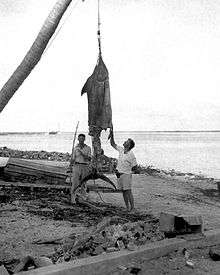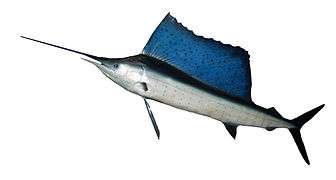The Old Man and the Sea
The Old Man and the Sea is a short novel written by the American author Ernest Hemingway in 1951 in Cuba, and published in 1952.[1] It was the last major work of fiction by Hemingway that was published during his lifetime. One of his most famous works, it tells the story of Santiago, an aging Cuban fisherman who struggles with a giant marlin far out in the Gulf Stream off the coast of Cuba.[2]
 Original book cover | |
| Author | Ernest Hemingway |
|---|---|
| Country | United States |
| Language | English |
| Genre | Literary Fiction |
| Published | 1952 (Charles Scribner's Sons) |
| Media type | Print (hardback & paperback) |
| Pages | 127 |
| Awards | Pulitzer Prize for Fiction (1953) Nobel Prize in Literature (1954) |
| ISBN | 0-684-80122-1 |
| 813.52 | |
| LC Class | PS3515.E37 |
In 1953, The Old Man and the Sea was awarded the Pulitzer Prize for Fiction, and it was cited by the Nobel Committee as contributing to their awarding of the Nobel Prize in Literature to Hemingway in 1954.[2]
Plot summary
The Old Man and the Sea tells the story of a battle between an aging, experienced fisherman, Santiago, and a large marlin. The story opens with Santiago having gone 84 days without catching a fish, and now being seen as "salao", the worst form of unluckiness. He is so unlucky that his young apprentice, Manolin, has been forbidden by his parents to sail with him and has been told instead to fish with successful fishermen. The boy visits Santiago's shack each night, hauling his fishing gear, preparing food, talking about American baseball and his favorite player, Joe DiMaggio. Santiago tells Manolin that on the next day, he will venture far out into the Gulf Stream, north of Cuba in the Straits of Florida to fish, confident that his unlucky streak is near its end.
On the eighty-fifth day of his unlucky streak, Santiago takes his skiff into the Gulf Stream, sets his lines and by noon, has his bait taken by a big fish that he is sure is a marlin. Unable to haul in the great marlin, Santiago is instead pulled by the marlin, and two days and nights pass with Santiago holding onto the line. Though wounded by the struggle and in pain, Santiago expresses a compassionate appreciation for his adversary, often referring to him as a brother. He also determines that, because of the fish's great dignity, no one shall deserve to eat the marlin.
On the third day, the fish begins to circle the skiff. Santiago, worn out and almost delirious, uses all his remaining strength to pull the fish onto its side and stab the marlin with a harpoon. Santiago straps the marlin to the side of his skiff and heads home, thinking about the high price the fish will bring him at the market and how many people he will feed.
On his way in to shore, sharks are attracted to the marlin's blood. Santiago kills a great mako shark with his harpoon, but he loses the weapon. He makes a new harpoon by strapping his knife to the end of an oar to help ward off the next line of sharks; five sharks are slain and many others are driven away. But the sharks keep coming, and by nightfall the sharks have almost devoured the marlin's entire carcass, leaving a skeleton consisting mostly of its backbone, its tail, and its head. Santiago knows that he is destroyed and tells the sharks of how they have killed his dreams. Upon reaching the shore before dawn on the next day, Santiago struggles to his shack, carrying the heavy mast on his shoulder, leaving the fish head and the bones on the shore. Once home, he slumps onto his bed and falls into a deep sleep.
A group of fishermen gather the next day around the boat where the fish's skeleton is still attached. One of the fishermen measures it to be 18 feet (5.5 m) from nose to tail. Pedrico is given the head of the fish, and the other fishermen tell Manolin to tell the old man how sorry they are. Tourists at the nearby café mistakenly take it for a shark. The boy, worried about the old man, cries upon finding him safe asleep and at his injured hands. Manolin brings him newspapers and coffee. When the old man wakes, they promise to fish together once again. Upon his return to sleep, Santiago dreams of his youth—of lions on an African beach.
Background and publication
Ernest Hemingway in 1954[3]
Written in 1951, The Old Man and the Sea is Hemingway's final full-length work published during his lifetime. The book, dedicated to Charlie Scribner and to Hemingway's literary editor Max Perkins,[4][5] was simultaneously published in book form – featuring black and white illustrations by Charles Tunnicliffe and Raymond Sheppard[6] – and featured in Life magazine on September 1, 1952. The first edition print run of the book was 50,000 copies and five million copies of the magazine were sold in two days.[7][8]
The Old Man and the Sea became a Book of the Month Club selection, and made Hemingway a celebrity.[9] In May 1953, the novel received the Pulitzer Prize[6] and was specifically cited when in 1954 he was awarded the Nobel Prize in Literature which he dedicated to the Cuban people.[10][11] The success of The Old Man and the Sea made Hemingway an international celebrity.[9] The Old Man and the Sea is taught at schools around the world and continues to earn foreign royalties.[12]
Literary significance and criticism
The Old Man and the Sea served to reinvigorate Hemingway's literary reputation and prompted a reexamination of his entire body of work. The novel was initially received with much popularity; it restored many readers' confidence in Hemingway's capability as an author. Its publisher, Scribner's, on an early dust jacket, called the novel a "new classic", and many critics favorably compared it with such works as William Faulkner's short story The Bear and Herman Melville's novel Moby-Dick.
Several critics note that Santiago hails from the Canary Islands, and that his Spanish origins have an influence in the novella.[13][14][15] After immigrating to Cuba in his 20s, later in life Santiago dreams about the Canary Islands and mixes Cuban and Peninsular Spanish vocabulary. His biography has many similarities to that of Gregorio Fuentes, Hemingway’s first mate.[16]
Gregorio Fuentes, who many critics believe was an inspiration for Santiago, was a blue-eyed man born on Lanzarote in the Canary Islands. After going to sea at age ten on ships that called in African ports, he migrated permanently to Cuba when he was 22. After 82 years in Cuba, Fuentes attempted to reclaim his Spanish citizenship in 2001.[17] Critics have noted that Santiago was also at least 22 when he immigrated from Spain to Cuba, and thus old enough to be considered an immigrant—and a foreigner—in Cuba.[18][19]
Hemingway at first planned to use Santiago's story, which became The Old Man and the Sea, as part of an intimacy between mother and son. Relationships in the book relate to the Bible, which he referred to as "The Sea Book". Some aspects of it did appear in the posthumously published Islands in the Stream. Hemingway mentions the real life experience of an old fisherman almost identical to that of Santiago and his marlin in On the Blue Water: A Gulf Stream Letter (Esquire, April 1936).[20][21]
Joseph Waldmeir's essay "Confiteor Hominem: Ernest Hemingway's Religion of Man" is a favorable critical reading of the novel—and one which has defined analytical considerations since. Perhaps the most memorable claim is Waldmeir's answer to the question—What is the book's message?
The answer assumes a third level on which The Old Man and the Sea must be read—as a sort of allegorical commentary on all his previous work, by means of which it may be established that the religious overtones of The Old Man and the Sea are not peculiar to that book among Hemingway's works, and that Hemingway has finally taken the decisive step in elevating what might be called his philosophy of Manhood to the level of a religion.[22]
Waldmeir considered the function of the novel's Christian imagery, most notably through Hemingway's reference to the crucifixion of Christ following Santiago's sighting of the sharks that reads:
"Ay," he said aloud. There is no translation for this word and perhaps it is just a noise such as a man might make, involuntarily, feeling the nail go through his hands and into the wood.[23]
One of the most outspoken critics of The Old Man and the Sea is Robert P. Weeks. His 1962 piece "Fakery in The Old Man and the Sea" presents his argument that the novel is a weak and unexpected divergence from the typical, realistic Hemingway (referring to the rest of Hemingway's body of work as "earlier glories").[24] In juxtaposing this novel against Hemingway's previous works, Weeks contends:
The difference, however, in the effectiveness with which Hemingway employs this characteristic device in his best work and in The Old Man and the Sea is illuminating. The work of fiction in which Hemingway devoted the most attention to natural objects, The Old Man and the Sea, is pieced out with an extraordinary quantity of fakery, extraordinary because one would expect to find no inexactness, no romanticizing of natural objects in a writer who loathed W. H. Hudson, could not read Thoreau, deplored Melville's rhetoric in Moby Dick, and who was himself criticized by other writers, notably Faulkner, for his devotion to the facts and his unwillingness to 'invent.'[24]
Legacy
In 1954, Hemingway wanted to donate his Nobel Prize in Literature gold medal to the Cuban people. To avoid giving it to the Batista government, he donated it to the Catholic Church for display at the sanctuary at El Cobre, a small town outside Santiago de Cuba where the Marian image of Our Lady of Charity is located. The Swedish medal was stolen in the mid 1980s, but the police recovered it within a few days.[25][26]
The Old Man and the Sea has been adapted for the screen three times: a 1958 film starring Spencer Tracy, a 1990 miniseries starring Anthony Quinn, and a 1999 animated short film. It also inspired the 2012 Kazakhstani movie The Old Man, which replaces the fisherman with a shepherd struggling to protect his flock from wolves. It is often taught in high schools as a part of the American literature curriculum.
In 2003, the book was listed at number 173 on the BBC's The Big Read poll of the UK's 200 "best-loved novels".[27]
References
- The Editors (August 25, 1952). "From Ernest Hemingway to the Editors of Life". Life. Time Inc. 33 (8): 124. ISSN 0024-3019.
Hemingway's work is a 27,000-word novel called The Old Man and the Sea.
- "The Nobel Prize in Literature 1954". The Nobel Foundation. Retrieved March 23, 2020.
- "Books: An American Storyteller". TIME. December 13, 1954. Retrieved February 1, 2011.
- Hemingway. The Old Man and the Sea. p. 5
- Perkins, Maxwell (2004). Bruccoli, Matthew J.; Baughman, Judith (eds.). The sons of Maxwell Perkins: letters of F. Scott Fitzgerald, Ernest Hemingway, Thomas Wolfe, and their editor. University of South Carolina Press. p. xxvii. ISBN 1-57003-548-2.
- Meyers 1985, p. 489
- Oliver 1999, p. 247
- "A Hemingway timeline Any man's life, told truly, is a novel". The Kansas City Star. KansasCity.com. June 27, 1999. Archived from the original on October 12, 2008. Retrieved August 29, 2009.
- Desnoyers, p. 13
- "Heroes:Life with Papa". TIME. November 8, 1954. Retrieved December 12, 2009.
- "The Nobel Prize in Literature 1954". Nobelprize.org. Retrieved October 4, 2009.
- Meyers 1985, p. 485
- Herlihy-Mera, Jeffrey (2017). "Cuba in Hemingway". The Hemingway Review. 36: 8–41.
- Guinea Ulecia, Mercedes (2016). "Hibridación lingüística y cultural en autores norteamericanos de origen español". Universidad de Huelva. diss.: 105–107.
- Herlihy, Jeffrey (2009). "Santiago's Expatriation from Spain". The Hemingway Review. 28: 25–44.
- Herlihy-Mera, Jeffrey (2017). "Cuba in Hemingway". The Hemingway Review. 36: 8–41.
- "El pescador que inspiró a Hemingway 'El viejo y el mar' recupera la nacionalidad española". Retrieved June 7, 2013.
- Herlihy-Mera, Jeffrey (2017). "Cuba in Hemingway". The Hemingway Review. 36: 8–41.
- Herlihy, Jeffrey. "Eyes the same color as the sea: Santiago's Expatriation from Spain and Ethnic Otherness and in Hemingway's the Old Man and the Sea". Hemingway Review. Retrieved April 17, 2015.
- Old Man and the Sea. Introduction: The Ripening of a Masterpiece. Simon and Schuster. Retrieved September 29, 2012.
- Hemingway, Ernest (edited by William White) (1967). By-Line: Ernest Hemingway. Selected articles and dispatches of four decades. New York: Scribner's.
- Joseph Waldmeir (1957). "Confiteor Hominem: Ernest Hemingway's Religion of Man". Papers of the Michigan Academy of Sciences, Arts, and Letters. XLII: 349–356.
- Hemingway. The Old Man and the Sea. p. 118
- Robert P. Weeks, Robert P. (1962). "Fakery in The Old Man and the Sea". College English. XXIV (3): 188–192. doi:10.2307/373283. JSTOR 373283.
- Miller, Tom (October 4, 2009). "Off The Shelf: The day Hemingway's Nobel Prize came out of hiding". Los Angeles Times. LA Times. Retrieved June 6, 2020.
- "Huffington Post". The Huffington Post. March 27, 2012. Retrieved October 7, 2014.
- "BBC – The Big Read". BBC. April 2003, Retrieved August 23, 2017
Sources
- Desnoyers, Megan Floyd. "Ernest Hemingway: A Storyteller's Legacy". John F. Kennedy Presidential Library Online Resources. John F. Kennedy Presidential Library and Museum. Retrieved December 9, 2011.CS1 maint: ref=harv (link)
- Meyers, Jeffrey (1985). Hemingway: A Biography. London: Macmillan. ISBN 0-333-42126-4.CS1 maint: ref=harv (link)
- Oliver, Charles M. (1999). Ernest Hemingway A to Z: The Essential Reference to the Life and Work. New York: Checkmark. ISBN 0-8160-3467-2.CS1 maint: ref=harv (link)
Further reading
- Baker, Carlos (1972). Hemingway: The Writer as Artist (4th ed.). Princeton University Press. ISBN 0-691-01305-5.
- Jobes, Katharine T., ed. (1968). Twentieth Century Interpretations of The Old Man and the Sea. Englewood Cliffs, New Jersey: Prentice Hall. ISBN 0-13-633917-4.
- Mellow, James R. (1992). Hemingway: A Life Without Consequences. New York: Houghton Mifflin. ISBN 0-395-37777-3.
- Young, Philip (1952). Ernest Hemingway. New York: Holt, Rinehart, & Winston. ISBN 0-8166-0191-7.
- Rosella Mamoli Zorzi; Gianni Moriani; Arrigo Cipriani (2011). In Venice and in the Veneto with Ernest Hemingway. In Venice and in the Veneto with... (in English and Italian). Venice: Supernova. pp. III, 62. ISBN 9788896220474. OCLC 843177468 – via archive.is.
External links
- The Old Man and the Sea at Faded Page (Canada)
- Rare, Unseen: Hemingway in Cuba—slideshow by Life magazine
- "Michael Palin's Hemingway Adventure: Cuba". PBS. Retrieved January 21, 2006.
| Awards and achievements | ||
|---|---|---|
| Preceded by Winston Churchill 1953 |
Nobel Prize in Literature 1954 |
Succeeded by Halldór Laxness 1955 |

